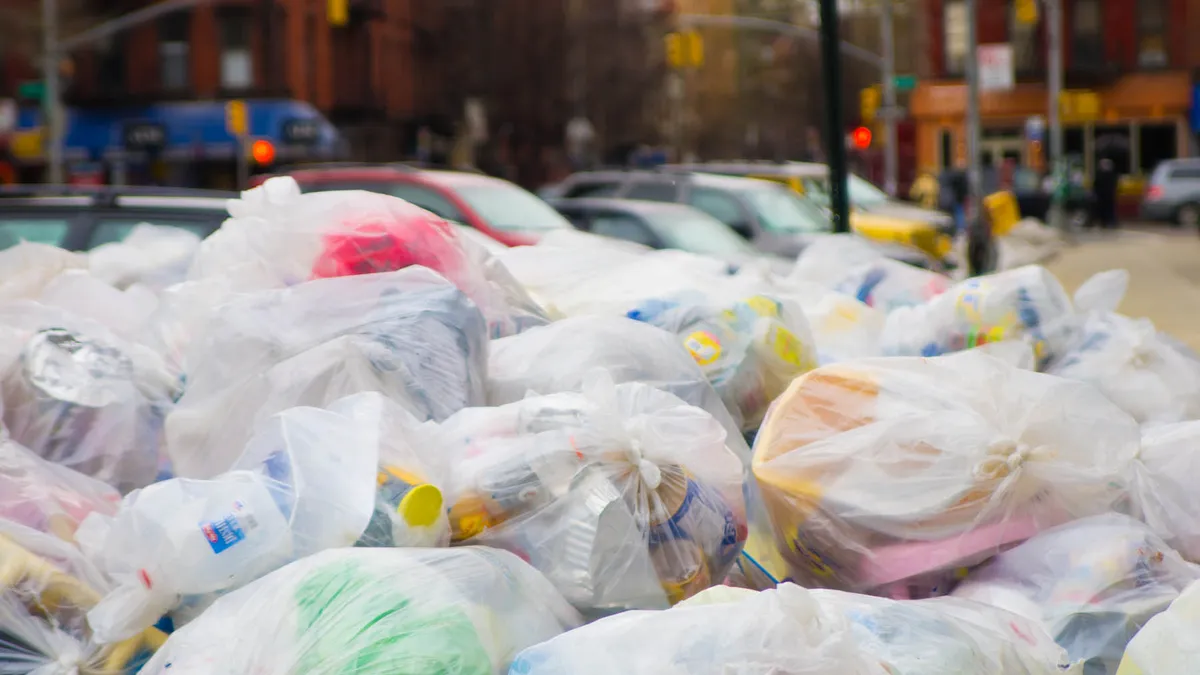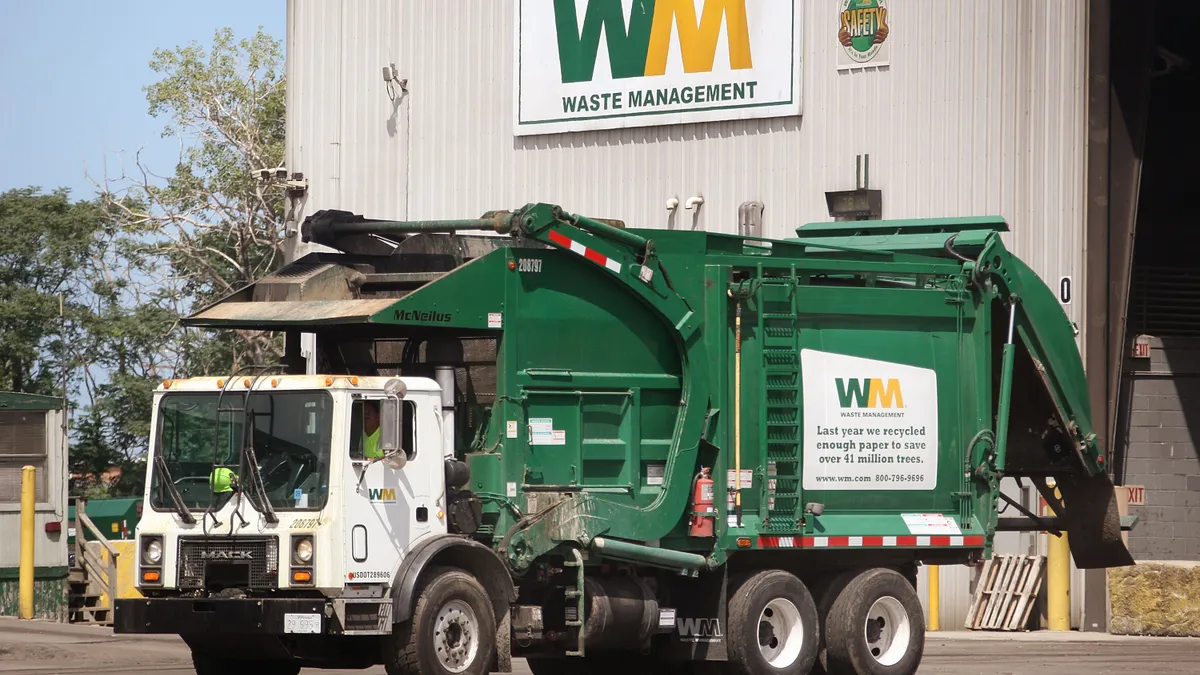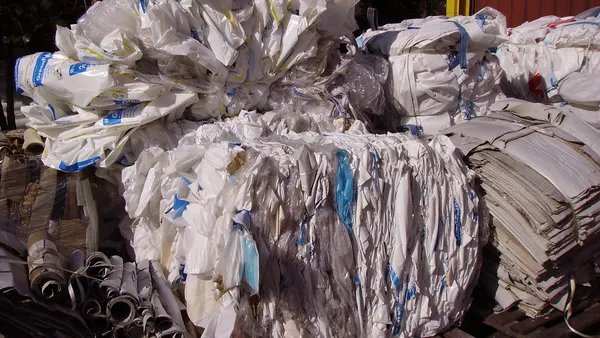Groups who want to shift recycling costs away from taxpayers and onto product packaging producers are racing to be the first to pass extended producer responsibility (EPR) laws this year.
Several states have seen unsuccessful bills in the past, but stakeholders predict a combination of pressure from lawmakers, growing public concern about the environment and rising recycling costs could make 2021 the year at least one state passes the nation's first EPR policy for packaging.
Although the bills in each state differ, most are designed to hold packaging producers, especially those behind single-use or hard-to-recycle plastics, accountable for the costs associated with managing their material in the waste and recycling stream.
“This year there’s so much excitement, momentum and attention” around EPR for packaging, said Sydney Harris, a senior associate and packaging lead for the Product Stewardship Institute (PSI), a nonprofit organization that has helps craft and support EPR legislation for packaging and other materials.
The latest effort to move EPR forward comes from the EPR for Packaging Network, a group of lawmakers in nine states that have introduced or plan to introduce EPR legislation. Facilitated by the National Caucus of Environmental Legislators, lawmakers representing California, Colorado, Hawaii, Maryland, New Hampshire, New York, Oregon, Vermont and Washington state say a coordinated advocacy campaign will be more effective than individual state approaches. They view the caucus as a key step in mitigating issues with the management of single-use plastic products.
“Plastic waste is a global crisis that is threatening our oceans, marine life, the environment, and public health,” said California State Sen. Ben Allen in a statement this month announcing the network. “It’s also hitting regular folks who are being asked to pay more and more through their trash rates to put band-aids on our system.”
The coalition is just one part of the ongoing push to introduce more packaging responsibility or product stewardship bills, broadly referred to as EPR, across the country.
Maine is expected to see the reintroduction of a bill from 2020 that initially gained momentum in the legislature before COVID-19 cut the session short. Environmental advocates believe a competing bill backed by certain producers could be introduced in the state around the same time, said Sustainable Maine Director Sarah Nichols, who works at the Natural Resources Council of Maine.
Stakeholders are also keeping an eye on EPR bills being discussed in Massachusetts, which has introduced several proposals in the past, said Alex Truelove, director of the zero waste campaign for U.S. PIRG.
States with active EPR bills
These bills are in various stages of moving through the lawmaking process, and Harris said many likely will undergo several rounds of amendments and rewrites to accommodate the interests of stakeholders such as environmental groups, haulers, recyclers and producers.
-
California SB 54: Led by Sens. Ben Allen, Henry Stern and Scott Wiener, the Plastic Pollution Producer Responsibility Act would aim to achieve a 75% source reduction, recycling, and reuse goal in part by making businesses financially responsible for management and recovery of plastic waste. Previous versions of this bill failed to pass in 2019 and 2020.
-
Hawaii HB 1316: Led by Rep. Nicole Lowen, the bill calls for packaging producers to be responsible for the management of waste “while ensuring minimal social and environmental impact." Producers would be required to submit annual reports on plans to fulfill these requirements. The Hawaii Department of Health would determine payment structures for the program. A separate bill, SB 1419 led by Sen. Laura Acasio, would establish a municipal product stewardship program
-
Maryland HB 36: This bill, led by Del. Brooke Lierman, would require producers of certain packaging, containers, and paper products to submit a “stewardship plan” to the Maryland Department of Environment by October 2022. Producers would be prohibited from selling those products without an approved stewardship plan by 2024.
-
Massachusetts HD1553: Introduced by Rep. Michael Day, the bill would direct packaging producers to establish a producer responsibility organization (PRO) and submit a stewardship plan for how the PRO will run the program and reimburse collectors. It also establishes an advisory committee made up of stakeholders and allows producers to propose alternative collection programs for certain packaging. Those monitoring the bill expect a parallel version to be introduced soon in the Senate.
-
New York S1185: Sen. Todd Kaminsky's bill would establish an EPR act mandating that producers cannot sell or distribute “covered materials” within three years of the bill's passage without an approved plan, but would have exemptions for producers under certain revenue and waste generation thresholds.
-
Oregon HB 2592: Rep. Janeen Sollman's bill would require producers of covered products to join EPR programs and submit a plan detailing how they intend to collect waste, make investments in recycling infrastructure and reduce the sources of covered products to the greatest extent possible. Certain exemptions for small producers are included. An additional draft bill, HB 2065, backed by Oregon's Department of Environmental Quality, would call for a “significant overhaul of state policy that would modernize Oregon’s recycling system” and ask producers to pay for part of these improvements.
-
Washington SB 5022: Headed up by Sen. Mona Das, the bill supports recycling and waste reduction by making sure packaging materials are 90% reused or recycled by 2040. It calls for using EPR to help achieve that goal.
Upcoming legislation expected
Several states, including some not on the NCEL list, are also expected to introduce EPR legislation in the near future.
-
Colorado: NCEL says the state is working on a comprehensive plastic pollution reduction bill led by Rep. Alex Valdez meant to “prepare for an extended producer responsibility model.”
-
New Hampshire: The state plans to consider several bills reducing plastic waste products and hazardous substances, such as PFAS, within food packaging materials.
-
Vermont: Sen. Chris Bray says the state is planning a bill establishing EPR for packaging.
-
Maine: Rep. Nicole Grohoski plans to introduce an EPR bill for packaging that would create a municipal reimbursement program and establish a packaging stewardship organization funded but not completely run by product producers. An additional producer-backed bill is likely also in the works, Nichols said, with both expected to come "very soon."
Rising support for packaging EPR
EPR programs already exist in the U.S. for a variety of products like paint, carpet, batteries, mattresses and pharmaceuticals, but there are no state programs for packaging.
Scott Cassel, PSI’s CEO, said more states have begun to propose EPR solutions in the past few years following a “perfect storm” of issues affecting U.S. recycling systems. The cost to run municipal recycling systems has skyrocketed in recent years, he said, partly because markets for recycled materials have changed in light of shifting international trade policies. Producers have also created more complex packaging that cannot always be recycled.
“Municipalities and taxpayers currently bear the brunt of this financially to manage it, and it is a paradigm shift to hold the producers responsible at different levels in different states," said Cassel.
The COVID-19 pandemic has put further pressure on lawmakers to find workable funding solutions, especially as municipal budgets get tighter but residents continue to generate more single-use packaging, boxes from online purchases and other materials, said Kate Breimann, state director of Environment Maryland and a supporter of the state’s EPR bill.
“With the weight put on county and municipal governments, there’s some resentment that they have to keep bearing the cost. It makes sense to them that the people creating the waste will have to bear some of the costs," she said.
Speaking during a New York Senate Environmental Conservation Committee hearing on Feb. 2, Sen. Rachel May said she would support the EPR bill introduced by Sen. Kaminsky, in part because it seeks to even out the state’s funding system.
“Our whole recycling economy is turned upside down, when you talk about the cost ... recycling used to be revenue neutral or a money maker. Now it is a major expense taking away from other services counties provide,” said May, adding the EPR bill “would help take those expenses away from the counties and shift the whole economy into a more sustainable mode.”
Crafting EPR policies can also open doors to other recycling and waste reduction policies aimed at continually improving state systems by reducing disposal and encouraging more reusable items, Breimann said. Effective EPR programs not only widen the producer’s responsibility for managing waste, but also help incentivize the redesign of products in a way that can be better recycled or reused, U.S. PIRG's Truelove said.
The EPR plan spectrum
Even though EPR for packaging is a new concept in the U.S., it’s been commonplace in Europe for decades and in certain Canadian provinces and countries in Asia and South America in more recent years, Cassel said. There are various approaches on the EPR “spectrum” meant to weigh the interests and concerns of packaging manufacturers, waste and recycling service providers, local governments and others.
On one end is the municipal reimbursement model, where municipalities retain all or most of their control over managing existing recycling operations and contracts, Harris said. A stewardship group reimburses the local government for the cost of trucks, sortation, or other operational expenses. This is the most common strategy proposed in the slate of EPR bills so far, including those in Oregon and Washington. “Producers have less control over the program, but also less responsibility,” she said.
Maryland is another state proposing this model, said Del. Lierman, sponsor of that state's bill. Under the bill, Maryland would retain its current recycling systems and ask producers to contribute financially to transportation and sorting costs by paying fees into a product stewardship organization for certain covered products.
The bill leaves some of the details up to producers, such as the fee structure for these covered products, but the intent is for producers to pay higher fees for materials that are harder to recycle or have fewer end markets, she told lawmakers during a bill hearing in the the Maryland General Assembly's Environment and Transportation Committee on Tuesday.
“The goal is to reduce waste and help local governments cover costs of managing their residential waste management,” said Lierman.
New York’s proposed bill includes a similar municipal reimbursement structure and would prohibit producers from selling certain types of packaging without an approved producer responsibility plan. Producers would either comply with the law individually or join a PRO according to the bill’s text. It would ask the producers or PRO to come up with the funding mechanism to cover the costs of the program, and it would include incentives to reward producers for product design that reduce waste and increases the recyclability of the product.
PSI's Harris said New York’s law would also include a method for carrying out the program in areas of the state where the municipality is not in charge of running the recycling programs.
At the other end of the spectrum is a “full producer responsibility” model where the stewardship organization would manage much more of the recycling process, including contracting with MRFs and haulers or running day-to-day operations, leaving the local government out of the operational process, Harris said.
Hawaii’s HB 1316 is considered “full producer” as currently written, Harris said, because it would allow packaging producers to enter into contractual agreements with counties to collect or manage waste. Canada’s provincial EPR system in British Columbia is seen as a key model, she said. Producers in that province have financial and operational responsibility, and local governments can contract with producers to continue recycling program operations.
Balancing interests for success
Although more EPR bills for packaging have popped up this year, not everyone is on board. Yet in recent years, some stakeholders who were previously opposed have slowly warmed to the concept or become more neutral – if certain conditions are met.
Republic Services was among the waste haulers to announce an updated stance on EPR in 2020, saying it would conditionally support programs that maintain existing recycling infrastructure and allow haulers and recyclers control of existing systems. Waste Management was originally among the notable opponents of California’s SB 54 2019, noting in regulatory filings that EPR could affect contract terms and pricing, but also took an updated approach last year.
During a December webinar hosted by the Solid Waste Association of North America (SWANA) and PSI, multiple recycling companies highlighted potential concerns.
Abbie Webb, sustainability director for Casella Waste Systems, said she was concerned about bills that don't recognize the needs of rural communities or address how to handle funding in areas with subscription service instead of municipal or county contracts. She echoed the point of other panelists who expressed concerns over EPR bills that could hurt haulers’ ability to maintain relationships with municipal customers.
"Anything that cuts into our ability to directly contract with our customers I think is a mistake," said Webb.
Beyond shifting stances from the waste and recycling industry, other notable players in the space have more recently come out in support of certain fee-based models that would maintain the existing system, but are not yet known to be supportive of specific EPR bills.
Dylan de Thomas, vice president of external affairs at The Recycling Partnership, recently said EPR is a “key component” of creating a more circular economy, but stressed that stakeholders from all parts of the system need to be among the decision makers. He spoke during a panel in February unveiling a federal recycling initiative from the Recycling Leadership Council, led by the Consumer Brands Association, packaging companies and brand-backed nonprofits.
The National Waste & Recycling Association (NWRA) has also updated its language on EPR in the group's latest federal and legislative policy agenda. NWRA said it may support EPR programs that prioritize funding and input from the waste and recycling sector and "take into consideration its impact on collection and processing operations while recognizing contractual relationships and existing industry investments."
AMERIPEN, a group that represents major brands like Procter & Gamble and cardboard manufacturer Pratt Industries, has opposed EPR initiatives in the past, including those in Maine. Executive Director Dan Felton recently told Resource Recycling the industry group would potentially support EPR under certain circumstances, such as if producer funding went mainly toward enhancing recycling instead of reimbursing municipalities.
PSI's Cassel said packaging producers have recently become more involved after years of hesitance or opposition because of potential momentum on the topic.
"They can no longer stay on the sidelines and they need to be part of the discussions. They want a seat at the table,” he said.
In PSI's view, EPR bills have a better chance of passing and succeeding when they integrate producers, recyclers, haulers and other stakeholders. Some of the bills on the docket this year, including in New York, Hawaii, and Oregon, went through intensive stakeholder processes before being introduced, he said.
While these conversations happen at a state level, stakeholders are also keeping an eye on what could happen at a national level, especially with the Break Free From Plastic Pollution Act. When introduced in 2020, that bill called for EPR programs and product stewardship for packaging, plastic bans or reduction efforts and a nationwide 10-cent beverage container deposit program.
Heidi Sanborn, executive director of the National Stewardship Action Council, said she expects the bill to return “with a vengeance” in 2021. Her organization has worked to implement EPR programs for various materials, including the first state program for pharmaceuticals, and says local programs can serve as blueprints for state or federal efforts.
“When catalyzing the shift to circular economy, EPR is one tool in the toolbox,” she said during at SWANA’s WASTECON in January.
Even if the Break Free From Plastic Pollution Act does not move right away, some think the passage of at least one state bill could start setting a new status quo.
David Biderman, executive director of SWANA, said the federal bill shows just how much of a priority EPR and other recycling-related improvements could become in the next few years, but he believes the U.S. needs to effectively mesh state and federal policies to make a lasting impact on the country’s dated waste and recycling systems.
“You can’t look at states in isolation, or the federal government EPR in isolation. You need them both,” he said.
This story has been updated to reflect the recent introduction of a bill in Massachusetts.



















